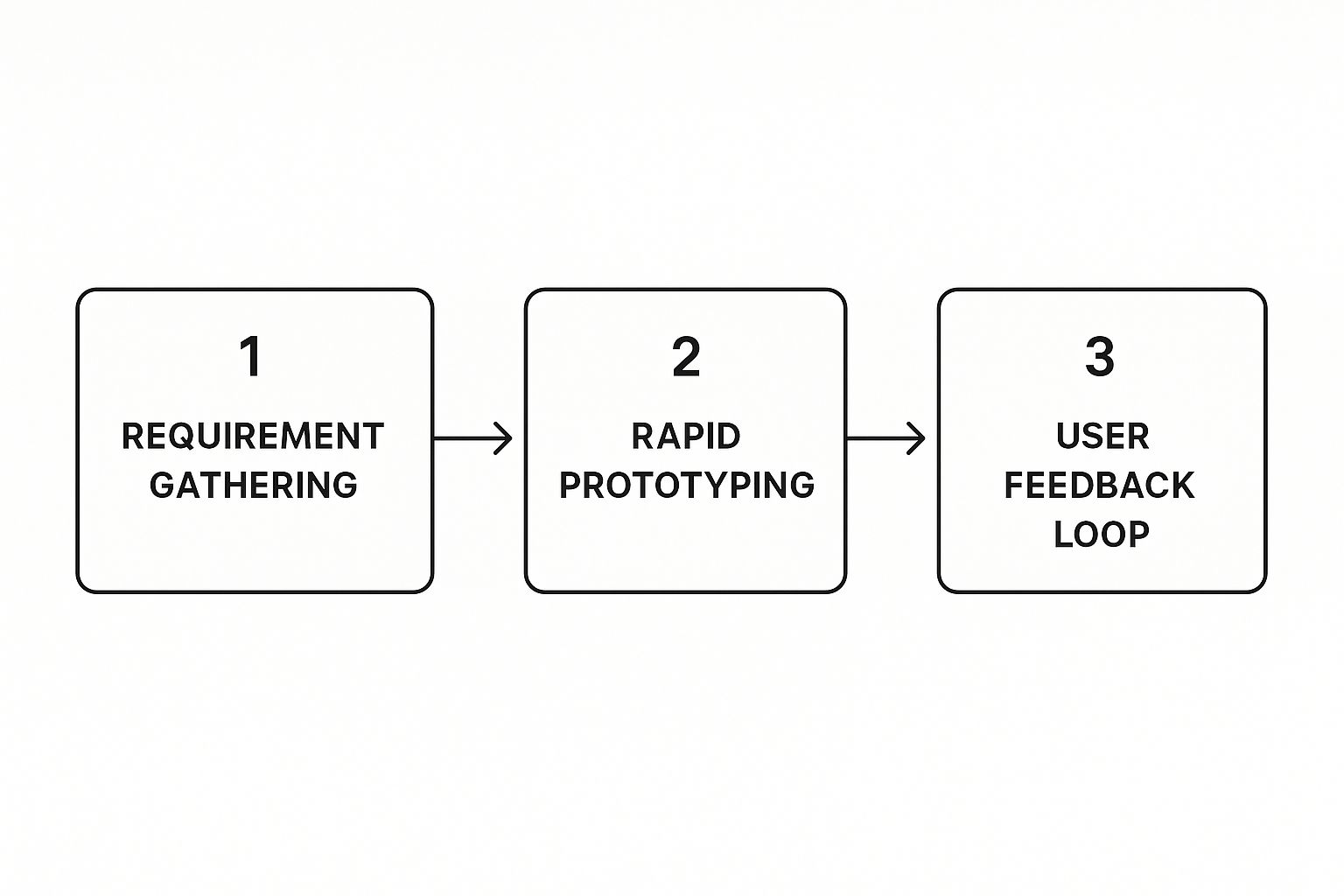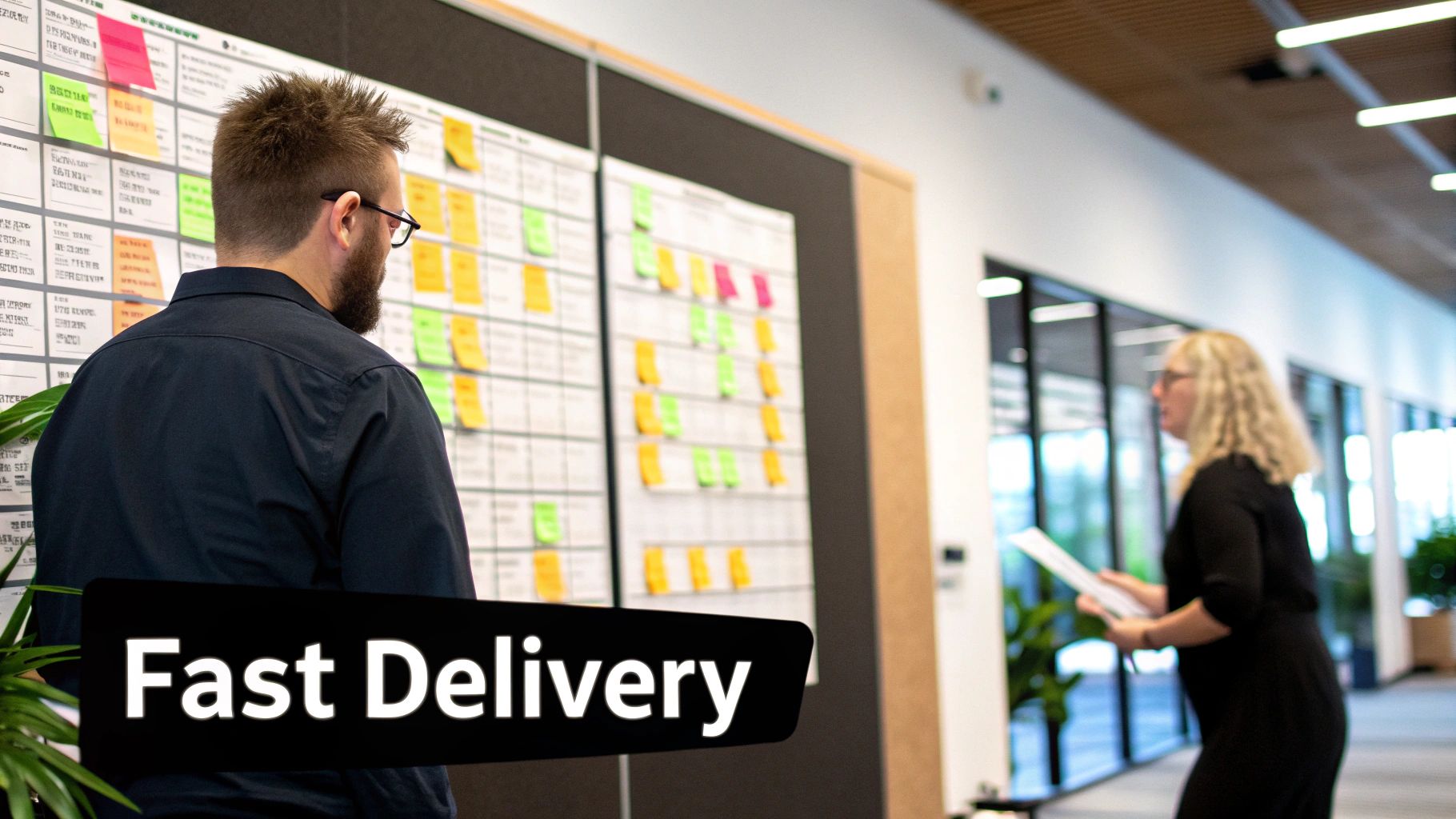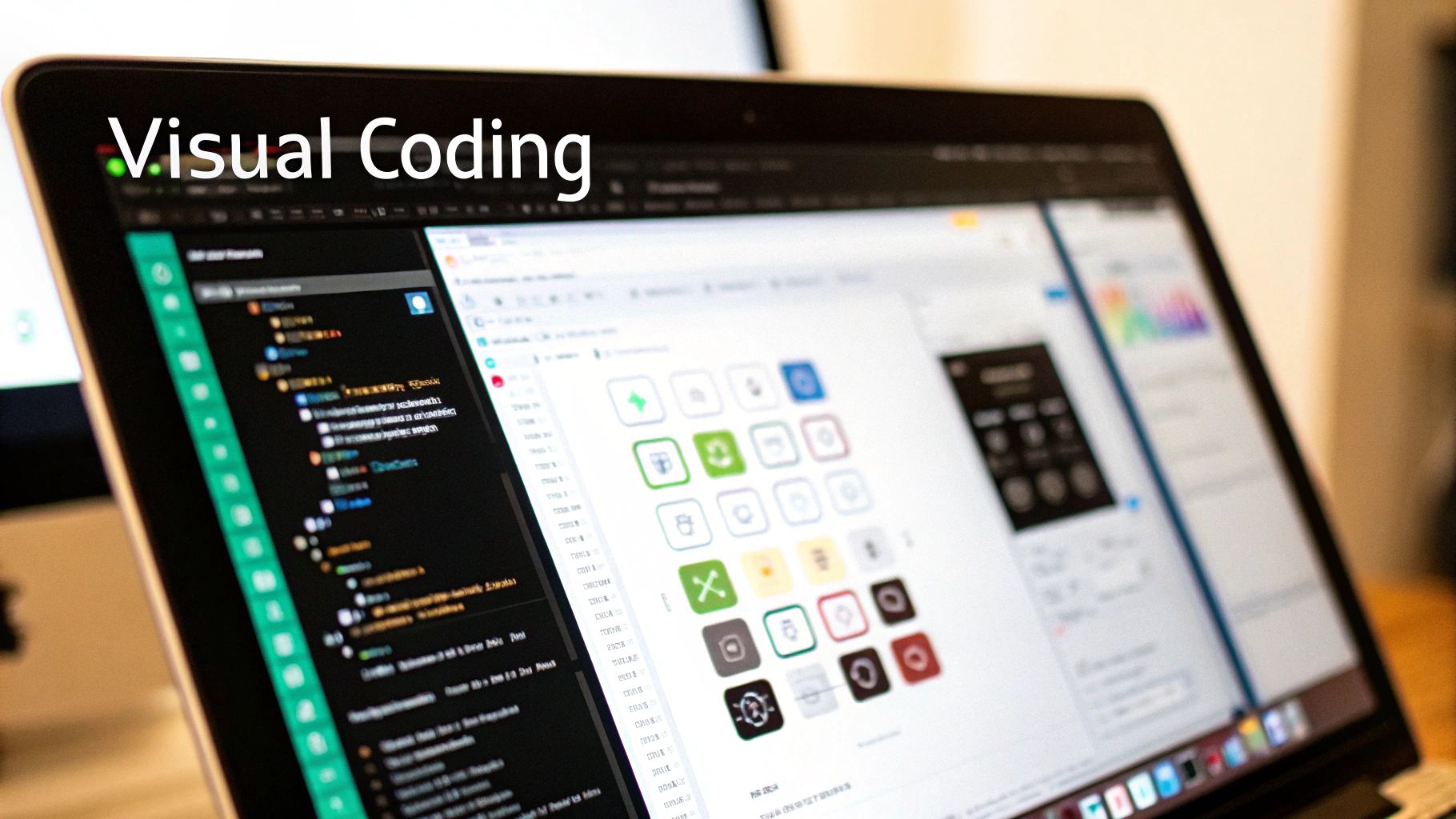Rapid Application Development: Build Software Fast & Smart
Rapid Application Development: Build Software Fast & Smart
Understanding RAD Without The Tech Jargon
Imagine you're building a custom piece of furniture. The old-school way is like carving it from a single, massive block of stone. You spend weeks planning every single detail, draw up a final blueprint, and only then do you start chipping away. If you find out halfway through that the client actually wanted a drawer instead of a cabinet, it’s a massive setback. This rigid, step-by-step process is a lot like the traditional Waterfall model of software development.
Now, picture building that same furniture with a sophisticated set of LEGO blocks. This is Rapid Application Development (RAD). Instead of one unchangeable plan, you start with a general idea and quickly snap together a basic prototype. You show this to the client, who can immediately see it and give feedback. "This looks great," they might say, "but can we make this section taller and add wheels?" With LEGOs, making that change takes minutes. You swap a few blocks, get more feedback, and repeat the cycle. This collaborative, hands-on approach is the essence of RAD.
From Rigid Blueprints to Collaborative Conversations
The main difference in the rapid application development model is how it treats requirements. In older models, requirements were treated like commandments set in stone before any real work began. In RAD, they are simply conversation starters. This isn't a new concept; it appeared in the 1980s and was officially defined in the early 1990s by individuals like James Martin as a direct answer to the slow, inflexible Waterfall method.
Early supporters understood that software could be easily changed, a key idea that led to the focus on prototyping and user feedback. This change produced big results; studies from the late 1990s revealed that RAD projects finished 40% faster on average and had 30% fewer cost overruns than their Waterfall counterparts. You can learn more about the history and influence of this method with these historical development insights from Wikipedia.
The image below shows this looping cycle, which is a core concept that separates RAD from linear models.

This diagram shows the continuous loop of prototyping, user testing, and refinement—the engine that gives RAD its speed and flexibility. The goal isn't just to build faster, but to build smarter by making sure the final product truly solves the user's problem.
The Four Phases That Make RAD Actually Work
The power of rapid application development isn't about skipping steps; it's about executing the right steps with focused efficiency. Think of it less like a frantic sprint and more like a well-choreographed dance with four distinct phases that flow together. Each phase builds upon the last, creating a rhythm that keeps projects moving and stakeholders engaged. This structure ensures speed doesn't come at the expense of quality or user satisfaction.
Phase 1: Requirements Planning
The first phase, requirements planning, is a collaborative workshop, not a one-sided lecture. Instead of creating a massive, rigid requirements document, the team—including developers, end-users, and key stakeholders—gathers to define the project's broad goals and essential features. This is more about agreeing on the core problem to solve than listing every possible function.
The goal is to establish a shared vision quickly, often in a single meeting, creating a flexible foundation that can adapt as the project evolves. By keeping this phase concise, teams avoid getting bogged down in "analysis paralysis" and can move swiftly into building something tangible.
Phase 2: User Design and Prototyping
Next comes the user design phase, where ideas become interactive. Developers build functional prototypes—working mockups of the application—that users can see, touch, and test. This hands-on approach is central to the rapid application development model. Stakeholders don't just read about features; they experience them.
They click through screens, test workflows, and provide immediate feedback. This iterative cycle of prototyping and feedback happens repeatedly, allowing the design to be refined and validated before any significant code is written. Each iteration brings the prototype closer to the final solution, ensuring the end product aligns perfectly with user expectations.

Phase 3: Rapid Construction
With a user-approved design in hand, the team enters the rapid construction phase. Here, the focus shifts to building out the full application based on the refined prototypes and user feedback. This stage is much faster than in traditional models because most of the major design decisions have already been made and validated.
Teams often use reusable components, low-code development platforms, and automated testing to accelerate the build. The work is broken down into smaller, manageable modules that can be built and tested in parallel, turning what used to be a long coding marathon into a series of focused sprints.
To better understand how these phases differ from a traditional approach, let's compare them directly. The following table highlights the key distinctions in activities and outcomes between RAD and the classic waterfall model.
RAD Phases vs Traditional Development Phases
A detailed comparison showing the activities, duration, and outcomes of each phase in RAD versus traditional waterfall methodology.
| Phase | RAD Approach | Traditional Approach | Key Benefits |
|---|---|---|---|
| Requirements | Collaborative workshops to define high-level goals. Flexible and adaptive. | Extensive documentation of all requirements upfront. Rigid and difficult to change. | RAD avoids "analysis paralysis" and allows for evolving requirements based on feedback. |
| Design | Interactive prototyping with continuous user feedback loops. | Detailed design documents and wireframes created in isolation. | Users get a hands-on feel for the product early, ensuring the final design meets their needs. |
| Construction | Rapid build process using reusable components and automated tools. Modules are built in parallel. | Linear coding phase where the entire application is built sequentially. | Development is significantly faster, and the modular approach reduces complexity. |
| Implementation | Smooth cutover with pre-trained users who have been involved throughout. | Big-bang deployment that can lead to user resistance and last-minute issues. | High user adoption and fewer surprises at launch due to continuous user involvement. |
This comparison shows that RAD's benefits come from its iterative, user-centric nature, which streamlines each step of the development lifecycle for faster, more relevant results.
Phase 4: Cutover and Implementation
Finally, the cutover phase marks the transition from development to a live, production environment. This includes final testing, user training, and data migration. Because users have been involved throughout the entire process, this final step is typically much smoother.
There are no last-minute surprises or major feature disputes. The application is deployed, and the team transitions into a support role, gathering feedback for future iterations. This isn't the end but the beginning of the application's life, ready for continuous improvement based on real-world usage.
RAD vs Other Development Methods: Choosing Your Path

Choosing a development methodology is like picking the right vehicle for a trip. Rapid Application Development (RAD) is the sports car—fast, nimble, and perfect for getting to a nearby destination quickly. But if you're hauling heavy cargo across the country, a sturdy truck might be a better fit. The best choice depends entirely on your project's goals, team dynamics, and constraints.
To make the right decision, it's crucial to understand how RAD stacks up against other popular approaches. Each one has a unique philosophy and is suited for different kinds of projects.
RAD vs. Waterfall: Flexibility Over Formality
The classic comparison is between RAD and the Waterfall model. Think of Waterfall as building a house from a fixed, highly detailed blueprint. It's a strictly sequential process where one phase must be completed before the next can begin. This works well for projects with stable, well-understood requirements, like constructing a bridge or developing medical device software where predictability is non-negotiable.
The major drawback of Waterfall is its rigidity. If market demands shift halfway through the project, making changes is both difficult and costly. In contrast, RAD is built for change. Its iterative cycle of prototyping and feedback allows for continuous adjustments, making it a great fit for projects where the final product isn't set in stone from the start.
RAD vs. Agile: Similar Spirit, Different Focus
People often use rapid application development and Agile interchangeably. While they both value iterative progress and close customer collaboration, they have important differences. Agile is a broad philosophy with frameworks like Scrum or Kanban that focus on delivering working software in short, time-boxed cycles called sprints. The main goal is to consistently deliver small, functional pieces of the product.
RAD is more specific about its phases and places a heavy emphasis on rapid prototyping to gather feedback. An Agile team might deliver a small, functional feature in a two-week sprint. In that same timeframe, a RAD team might build and refine several different prototypes to perfect a single user experience. Agile prioritizes delivering a working part of the product, while RAD prioritizes delivering a working model of the product for feedback.
RAD vs. DevOps: A Powerful Partnership
DevOps isn't a development methodology in the same way as RAD or Agile. Instead, it's a cultural shift that breaks down the walls between development (Dev) and IT operations (Ops). The primary goal is to automate and integrate the processes between these teams to build, test, and release software faster and more reliably.
Rather than being an alternative, DevOps is a perfect complement to RAD. A team using RAD can adopt DevOps practices to automate the rapid construction and deployment phases. This synergy creates an incredibly fast feedback loop: build, test, deploy, and learn. Managing this pipeline often requires well-defined APIs. For guidance on creating seamless integrations, you can explore the top API development best practices that successful teams implement.
To help you visualize these differences, the comparison matrix below breaks down how each methodology performs across key factors.
Development Methodology Comparison Matrix
This table provides a comprehensive comparison of RAD, Agile, Waterfall, and DevOps across key factors like speed, flexibility, cost, and ideal use cases.
| Methodology | Speed | Flexibility | Cost | Best For | Team Size |
|---|---|---|---|---|---|
| Rapid Application Development (RAD) | Very Fast | High | Moderate | Projects with unclear requirements, user-facing apps, and MVPs. | Small, highly-skilled |
| Agile | Fast | High | Variable | Complex projects with evolving requirements and a need for incremental delivery. | Small to medium, collaborative |
| Waterfall | Slow | Low | Predictable (if no changes) | Projects with fixed, stable requirements and a low risk of change. | Large, structured |
| DevOps | Continuous | High | Variable | Enhancing any methodology to accelerate the entire delivery pipeline. | Varies, cross-functional |
As the table shows, there's no single "best" methodology—only the one that's best for your specific project. RAD shines when speed and user feedback are critical, while Waterfall offers predictability for stable projects. Agile provides a flexible framework for complex, evolving products, and DevOps enhances the efficiency of any approach it's paired with.
Why Smart Businesses Are Choosing RAD
The theory behind rapid application development is interesting, but the real-world results are what truly convince businesses to get on board. Organizations that adopt RAD are seeing improvements that go far beyond just faster project delivery. They are finally fixing chronic issues that have held them back for years: endless requirement changes, blown deadlines, and software that’s already dated by the time it launches.

From Catch-Up to Competitive Edge
For a long time, many companies have been stuck in a reactive loop, constantly trying to keep up with market shifts or internal demands. A startup founder might have a great idea but faces a nine-month development timeline, giving a competitor plenty of time to enter the market first. In a larger company, an enterprise team might be stuck with clunky internal tools because the traditional development process is too slow and costly to justify building something better.
RAD changes this entire dynamic by helping businesses act on opportunities instead of just reacting to problems. Rather than waiting for a flawless final product, a startup can launch a Minimum Viable Product (MVP) in weeks. This allows them to collect real user data that guides the rest of the development. An internal team can build and deploy a custom tool to solve an immediate pain point, boosting employee productivity and job satisfaction almost instantly. Moving from a slow, bureaucratic process to a fast, responsive one gives businesses a serious competitive advantage.
The Power of Tangible Progress
One of the most powerful, yet often overlooked, benefits of rapid application development is the positive psychological impact it has on teams. In traditional development models, developers might code for months without ever seeing their work in the hands of users. This lack of connection can lead to low morale and a sense that their efforts don't make a real difference.
RAD flips this script entirely. By building and testing prototypes in short, repeated cycles, developers see their ideas come to life and get direct feedback almost immediately. This constant loop of creation and validation is incredibly motivating. It reinforces the value of their work and connects them directly to the people they're building for. The outcome is a more engaged, energized, and productive development team that feels a strong sense of ownership over the final product.
The data supports this shift. Rapid application development is increasingly popular for its ability to deliver working software in a fraction of the time.
- Studies show that RAD projects often achieve a first release in 3–6 months, which is at least a 50% reduction in time-to-market compared to Waterfall projects.
- Around 70% of organizations using RAD report higher user satisfaction thanks to the frequent feedback cycles.
- Large enterprises in the U.K. and U.S. have saved millions by adopting RAD, reducing the need for development staff by 20–30% on certain projects. You can discover more insights on RAD's impact at Monday.com.
This speed doesn't just cut costs; it builds momentum.
Opting for RAD isn't just about trying a new process; it's about adopting a new mindset. It's a choice to prioritize speed, collaboration, and real-world feedback over rigid plans and lengthy documentation. For businesses that want to innovate faster and build products that people actually enjoy using, the choice is clear.
Tools That Transform RAD From Theory To Practice
While the principles of rapid application development offer a great game plan for speed and flexibility, you need the right tools to bring that plan to life. Without the proper technology, a RAD project can get messy, fast. Fortunately, there's a huge ecosystem of platforms and services designed to speed up every step, from the initial idea to the final launch.
The demand for these tools is massive. The global RAD tools market was valued at around $49.8 billion USD in 2022, showing just how essential these platforms have become for businesses wanting to build software faster. You can learn more about these market trends and the RAD methodology at Zoho.com. This growth is all about giving teams the power to build better and faster.
The Rise of Low-Code and No-Code Platforms
At the center of any modern RAD toolkit are low-code and no-code platforms. These tools have completely changed the game by allowing people without a technical background to build working applications. Think of them as high-tech Lego sets for software. Instead of writing code from scratch, users can drag and drop pre-made components, set up workflows visually, and piece together applications in a fraction of the usual time.
This approach is ideal for building a Minimum Viable Product (MVP). It allows founders and product managers to test their ideas quickly without a huge upfront investment in engineering. For a closer look at this process, check out our guide on how to build an MVP with limited resources. Platforms like Capacity push this even further, using AI to generate full-stack applications from a simple text description, which drastically shortens the construction phase.
Essential Tools for a RAD Workflow
Beyond low-code platforms, a successful rapid application development team depends on a collection of connected tools:
- Collaboration and Communication: Keeping the conversation flowing is key in RAD. Tools like Slack, Microsoft Teams, and Asana are vital for keeping everyone on the same page, especially for remote teams, and making sure feedback loops are quick and effective.
- Prototyping Tools: Platforms such as Figma and Adobe XD let designers and developers create interactive mockups. Stakeholders can click through these prototypes and give specific feedback that helps shape the final product before any major coding starts.
- Automated Testing Frameworks: To keep quality high while moving quickly, teams use automated testing tools like Selenium or Cypress. These frameworks run tests automatically after every change, catching bugs early before they can cause major delays.
- CI/CD and Deployment Solutions: Services like Jenkins, GitHub Actions, and Vercel automate the process of integrating and deploying code. This turns releasing new application versions into a simple, low-risk task instead of a stressful, all-hands-on-deck event.
By bringing these specialized tools together, teams can build a highly efficient pipeline that truly represents the core principles of RAD: speed, iteration, and collaboration.
RAD Success Stories From The Real World
Theory and methods are useful, but the real measure of rapid application development is how it solves actual business problems. Abstract ideas like prototyping and iterative feedback become tangible when we see them fix real challenges, save money, and open up new opportunities. These stories from different industries demonstrate that RAD isn't just about building faster—it's about creating smarter solutions that deliver results.
From Weeks to Hours in Financial Services
A regional bank was struggling with its commercial loan application process. The system was a jumble of manual paperwork, emails, and outdated software, pushing the average approval time to over two weeks. This slow pace frustrated clients and put the bank at a serious disadvantage.
Instead of starting a long and expensive traditional software project, the bank's team used a RAD approach. They began by working with loan officers and underwriters to create a simple prototype for a new digital portal.
- The Problem: The manual process was slow, lacked transparency, and was prone to data entry errors.
- The RAD Solution: A small team used a low-code platform to build an initial prototype in just one week. This allowed loan officers to test a basic digital workflow and give instant feedback.
- The Result: After three cycles of feedback and adjustments over two months, the bank launched a streamlined digital application system. The approval time dropped from weeks to an average of same-day approval, and data entry mistakes decreased by over 90%. The bank could now handle more loans with the same number of staff, directly increasing revenue.
Streamlining a Complex Manufacturing Supply Chain
A global manufacturer had trouble managing inventory across its various production plants. Their current system failed to provide real-time data, which led to having too much of some materials and not enough of others. These inefficiencies cost the company millions each year in storage fees and production halts.
The company needed a custom supply chain management tool but couldn't afford the time or risk of a large-scale traditional project. They chose rapid application development to build a solution specifically for their unique workflow.
- The Challenge: A lack of real-time inventory information was causing expensive production delays.
- The RAD Approach: The team concentrated on one high-impact feature first: a real-time dashboard for tracking essential components. They created a working prototype that connected to existing databases, giving supply chain managers a live look at inventory levels.
- The Outcome: The first dashboard prototype was so effective that it was rolled out within a month. Over the following six months, the team added more features, like predictive ordering and supplier communication tools. The final application saved the company an estimated $2 million in its first year by cutting down on excess inventory and preventing stockouts.
These examples illustrate that RAD is a practical strategy for achieving major business outcomes. Success often depends on having a clear grasp of the project's scope and costs from the start. For a closer look at this critical first step, you can find helpful information in our article on software development cost estimation. By starting small, involving users from the beginning, and building in stages, organizations can solve urgent problems and gain a significant competitive advantage.
Your RAD Implementation Roadmap
Switching to rapid application development isn't just about getting new software; it's about building a team culture that values speed and collaboration. Making this change work requires a solid plan to get your organization ready. This roadmap will walk you through checking if you're prepared, launching a trial project, and setting up the right measurements to see real results from the start. It’s about turning ideas into reality with a clear, practical guide.
Assess Your Readiness
Before you jump in, take an honest look at where your organization stands. Is your team culture open to trying new things and getting feedback quickly, or does it tend to resist change? Rapid application development works best in places where key stakeholders are easy to reach and ready to be part of the process.
You also need to look at your team's skills. Do they have experience with building in small, repeated cycles, or will they need some training? Understanding these cultural and technical starting points helps you clear potential hurdles before they slow you down.
Select the Perfect Pilot Project
Your first RAD project will be your proof that this method works, so choose it carefully. Don't start with a high-risk, essential system. Instead, pick a project with a clear, manageable goal and high visibility. A great choice is often an internal tool or a customer app that solves a specific, well-known problem.
Ideal pilot projects share these traits:
- High Impact, Low Risk: It should fix a real issue without putting core business functions at risk if there are bumps along the way.
- Engaged Stakeholders: The people who will use the final product should be excited and available to give regular feedback.
- Clear Success Metrics: You need to be able to easily track its effect, whether that's through time saved, happier users, or fewer mistakes.
A successful pilot project builds positive momentum and quiets any doubts, making it easier to adopt RAD more widely. It also creates internal advocates who can speak to how well the new process works.
Build Your A-Team and Establish Feedback Loops
A typical RAD team is small, includes people from different departments, and has the authority to make decisions. It should bring together developers, a business analyst, and, most importantly, direct representatives of the end-users. This tight-knit group needs to create strong communication habits and a consistent schedule for feedback.
Holding regular, organized meetings to review prototypes is a must. This constant conversation ensures the project continues to meet user needs and avoids the expensive do-overs that often trouble traditional development models. The aim is to create a steady stream of information between the people building the application and the people who will use it.
By carefully planning your rollout, you can successfully adopt a rapid application development model that delivers better results, faster. To speed up this process, platforms like Capacity can transform your ideas into full-stack applications in minutes, fully embracing the speed and efficiency of RAD. Discover how Capacity can jumpstart your next project.
